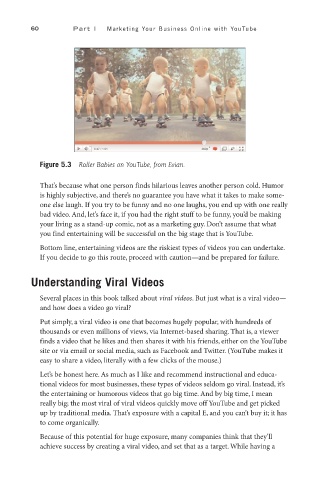Page 81 - SKU-000506274_TEXT.indd
P. 81
60 P a r t I Marketing Your Business Online with YouTube
Figure 5.3 Roller Babies on YouTube, from Evian.
That’s because what one person finds hilarious leaves another person cold. Humor
is highly subjective, and there’s no guarantee you have what it takes to make some-
one else laugh. If you try to be funny and no one laughs, you end up with one really
bad video. And, let’s face it, if you had the right stuff to be funny, you’d be making
your living as a stand-up comic, not as a marketing guy. Don’t assume that what
you find entertaining will be successful on the big stage that is YouTube.
Bottom line, entertaining videos are the riskiest types of videos you can undertake.
If you decide to go this route, proceed with caution—and be prepared for failure.
Understanding Viral Videos
Several places in this book talked about viral videos. But just what is a viral video—
and how does a video go viral?
Put simply, a viral video is one that becomes hugely popular, with hundreds of
thousands or even millions of views, via Internet-based sharing. That is, a viewer
finds a video that he likes and then shares it with his friends, either on the YouTube
site or via email or social media, such as Facebook and Twitter. (YouTube makes it
easy to share a video, literally with a few clicks of the mouse.)
Let’s be honest here. As much as I like and recommend instructional and educa-
tional videos for most businesses, these types of videos seldom go viral. Instead, it’s
the entertaining or humorous videos that go big time. And by big time, I mean
really big; the most viral of viral videos quickly move off YouTube and get picked
up by traditional media. That’s exposure with a capital E, and you can’t buy it; it has
to come organically.
Because of this potential for huge exposure, many companies think that they’ll
achieve success by creating a viral video, and set that as a target. While having a

